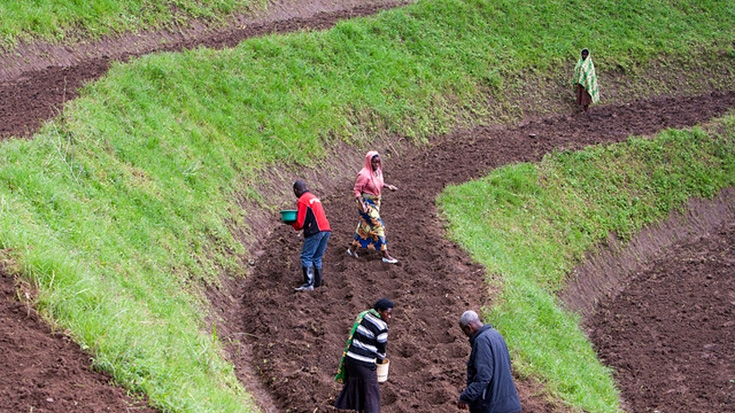CAPE TOWN, June 4, 2015— In Africa, economic growth has risen steadily for the past 15 years and rapid population growth holds the promise of a large emerging consumer market as well as an unprecedented labor force that could provide significant growth opportunities.
But the continent remains a largely agrarian economy with a large informal sector and growth driven mainly by natural resources. Despite consistent high growth rates, nearly one out of two Africans continues to live in extreme poverty, and income inequality remains among the highest in the world. In addition, across sectors – from agriculture, to manufacturing, to services – productivity levels remain low.
A new report from the World Bank Group – The Africa Competitiveness Report 2015 – provides detailed competitiveness profiles for the 40 African countries included in the World Economic Forum’s Global Competitiveness Index. The report provides country-specific context and highlights the unique challenges facing economies.
Africa’s best path forward, according to the report, is to turn high growth into sustainable and inclusive growth by raising productivity across all sectors of the economy and creating quality employment.
KEY FINDINGS
Transforming Africa’s economies
Although other regions have emphasized a growing manufacturing sector as the driving force of economic development, Africa’s path has been different. While agriculture continues to employ over half of the continent’s population, it is being slowly replaced by an expanding services sector, which accounts for over 50% of GDP.
This shift has taken place largely in the market service sector – most notably in retail, distribution and other trade services – employing 25% of the working-age population. But there is room for enhancement in labor productivity in both the agriculture sector and the trade service sector – where most agriculture employment has shifted.
Increasing agricultural competitiveness
Despite a wealth of arable land, Africa has the world’s highest rates of undernourishment and imports many food staples. The agricultural sector, largely characterized by small-scale subsistence production, has not benefited from the green revolution that aided much of the developing world.
Development of agricultural value chains integration is key to the sector’s success. The Africa Competitiveness Report emphasizes that value chains should include connections to large, commercial agribusiness, but also to small-scale farmers. In addition, a sound regulatory and institutional system, appropriate financial instruments, and increased spending in research are vital to encouraging production of high-yield crops. Furthermore, land reform will be particularly crucial for increasing access to land.
The role of services
The increasingly important role of services in economies across Africa is challenging the conventional understanding of the path of structural transformation. The report uses new trade statistics to show that service exports are much more significant for Africa than previously thought. Services, for example, account for 83% of the final price of Ethiopian roses in the Netherlands. Yet service exports from Africa remain a small portion of overall exports. To maximize potential gains from this sector, countries in Africa need to reduce direct barriers to trade in services as well as poor regulations that indirectly impede trade.
Tapping the potential of global value chains
Recent data suggests that participation in global value chains (GVCs) is associated with economic benefits, particularly for developing economies, where GVC participation helps countries enhance productivity, develop skills, and diversify exports.
The region’s participation in GVCs remains small, and two-thirds of that participation is related to the continent’s rich endowments in natural resources and low levels of industrialization. Further development of GVCs will depend on the implementation of a broad set of policies, with a particular focus on trade facilitation, investment policy, and improved transport infrastructure and access to finance.
Moving forward
The report finds that the following levers are most critical for addressing the continent’s challenges:
- Developing transport and ICT infrastructure: Increased spending on rural infrastructure will help reduce the continent’s dependence on rain-fed agriculture by supporting intensified irrigation, increasing resilience to climate change, and improving access to markets for intermediate inputs and agricultural produce. It will also help unlock (intra-) African trade and participation in regional and global value chains. ICT infrastructure is also critical to the provision of services within countries and across national borders.
- Increasing the quality of education: Although the continent has made considerable progress in improving access to primary education, enrolment rates in higher education remain disappointingly low. Empirical evidence shows that tertiary education enrolment is an important determinant of services in developing countries, primarily via skills and entrepreneurial activity.
- Reducing barriers to trade: Beyond the poor quality of physical infrastructure and high tariffs, estimates shows that 60% to 90% of trade costs relate to non-tariff measures. In addition, delays and unpredictability often impede the region’s participation in GVCs because many industries rely on just-in-time production and depend on the reliability of the supply of intermediate inputs. Essential steps include simplifying import-export procedures.
- Strengthening the regulatory framework: The absence of land markets prevent the most efficient farmers from scaling up their production, and insecure land tenure limits farmers’ ability to use their land as collateral and thus to access credit markets. Large parts of the service sector – such as telecommunications, professional services and transport services – are relatively restricted in many countries.
